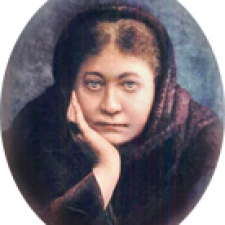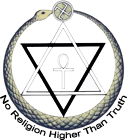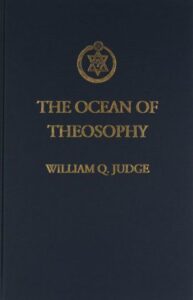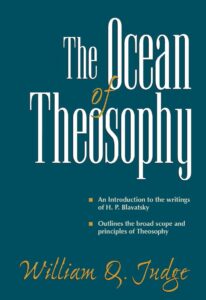Studies In The Ocean Of Theosophy Part XIII
Theosophy Magazine
Vol. 22, No. 1 November 1933
pages 33 - 36
THE term “Manas” is applicable either to Man or his fifth Principle, inasmuch as Manasic activity marks the “man stage” of evolution. Although one and indivisible, Manas is designated as “Higher” and “Lower”, its “nature becoming dual as soon as it is attached to a body.” The second or lower aspect is concurrent with embodiment through the focusing of attention on the physical plane, and the tendency of Manas to be “at once altered into the shape and other characteristics of any object, whether mental or otherwise”, thus becoming “tinted” by whatever is presented to it. Thoughts relative to sense perception modify the mind accordingly, causing it to function as Lower Manas; while aspirational thought produces the functioning of Higher Manas; the more the Thinker is “attached to a body”, the greater the cleavage in his consciousness.
The “human brain is a superior organism and Manas uses it to reason from premises to conclusions.” Some count this “the highest and best gift belonging to man”; but Theosophy teaches that it merely “differentiates man from animal”, without touching his real potentialities; that the human brain is attunable to titanic powers. Synchronized solely with the voice of the world and the roar of the senses, the present mass-mind is cut off from the Eternal during waking hours. Thus, the average man unaware of his inner greatness is unwittingly a house divided against itself. It is this schism against which the Elder Brothers constantly warn.
Intellectuals may not smile to hear their astute facilities — keen logic, skillful calculations, accurate memory — classified as inferior expressions of Manas. Deeper disapproval may frown down upon the statement that the Mind’s “other, and in Theosophy higher, aspect is the intuitional, which knows, and does not depend on reason.” And it may well be deemed effrontery to suggest still further that intuition is not only an actuality, but of practical value in any school or university curriculum. Yet, the world’s healing can begin only when educators seriously consider this fact and earnestly attempt to understand it; minds open to the possibility of higher capacities would soon initiate reforms long needed. For one thing, the kingdoms of Nature would be recognized as four. Spiritual powers will seem more plausible when Humanity is no longer classed as animal! Higher self-respect in this would arouse more compassion for the helpless brothers of the lower kingdoms, bringing revulsion for the tortures of vivisection and discernment not only of its utter lack of value but its imminent harm to Mankind. Also, methods of instruction would undergo change from cramming in to drawing out, employing memory in a deeper way — then, to be fittingly named “education”. The memorizing of cold facts and dry deductions, heedless of underlying meaning, converts the mind into a registering machine. Data and statistics have their value; but minds less indexed might draw upon inner memoirs, with less need for tabulation. Each mundane event is fraught with occult significance; objectivity is a field of symbols; both inward and outward enrichment rewards search for these meanings. When education makes “Head-learning” subservient to “Soul-Wisdom”, a new order of the ages shall begin.
Manas “retains all the impressions of a lifetime”, but “is so occupied with the brain, with memory, and with sensation” that it recollects little. These forgotten impressions, inwardly retained, carried from body to body, produce native aptitudes or disabilities. Any acquirement comes from effort; but the gains of merely Lower Manas represent burdensome baggage, rather than intrinsic value. For the “lower, and purely intellectual, is nearest to the principle of Desire, and is thus distinguished from its other side which has affinity for the spiritual principles above. If the Thinker, then, becomes wholly intellectual, the entire nature begins to tend downward; for intellect alone is cold, heartless, selfish, because it is not lighted up by the two other principles of Buddhi and Atma.”
Lack of brotherliness inflicts the injustices of class and social distinctions. A truth lurks in the village wag’s sally about “Senator Puff”, essentially descriptive of Kama-Manas, belittling others to elevate self. Character too seldom outweighs expressed abilities in the eyes of a populace stressing money and show. Yet appearances are no criterion at this juncture — pivot of the middle Round — when Karmic adjustments are in process against the upward sweep of future cycles. In chapter seven is portrayed how “the business man of today is a single type for whom business forms the “one single thread of thought”, but which includes as well the “man who has engaged in business, but also thought much upon fame and power which he never attained.” “The great mass of self-sacrificing, courageous, and strong poor people who have but little time to think, constitute another distinct class.” Among these may be those paying debts in menial service, the while gaining compassion and understanding — Karmic stamina for lives to be.
Many musicians may be drudging in offices; many artists tilling the soil; and many wise men, with “heads ground down” by poverty, thereby escape the “cold, heartless, selfish” peak of attainment.
Mystic Man dwells in a realm of thought, where each creates his own world of seeming, yet believes himself a weak child of Earth, inherently imperfect. Common observation shows no two seeing just alike; and experiment proves that “so called matter is not per se solid or dense; that sight does not always depend on the eye and rays of light proceeding from an object; that the intangible for one normal brain and organs may be perfectly tangible for another; and that physical effects in the body may be produced by an idea solely.” An idea held in one mind can appear as an external object to the mind of another and be sensed as such fully, even to “density and weight”. These discoveries corroborate the still more marvelous testimony of Theosophy and its consistent assertion that the visible universe is wrought by the mighty magic of prakriti. But behind the shadow stands the Real — a mightier Magic — that builds for permanency, approachable when the spell of the lesser is broken and Man — free from self-identification with its imagery — ceases to interpret it in terms of Kama.
Like unto Life’s ceaseless pulsation is “the natural motion of Manas”. Never quiet, here, save when brain action is stilled by sleep or insanity, and then still busy on other planes, the mind flits from subject to subject. Sages declare its restraint “to be as difficult as that of the wind.” Yet this is Humanity’s task. A thought calls up associated ideas; these usher others, all based on personal memories. Allied with the lower memory in this dispersion, is Kama, as desire or aversion, prompting the mind to “fly to some pleasant idea” or to “fly to an unpleasant idea” irrelevant to the duty at hand. “These mental characteristics all belonging to Lower Manas, are those which the Higher Manas, aided by Buddhi and Atma, has to fight and conquer.” Their effect is analogous to Society comments whispered in the ear of one contemplating some epic poem. Even thus is the stately meter of Soul Memory broken by paltry personal recollections. Once controlled by Higher Manas, the mind will still “fly”, but Will-directed, as obtains with “geniuses or great seers and prophets” sometimes seen along the pathway of life. In others, like some poets, “Higher Manas now and then sheds a bright ray on the man below, to be soon obscured, however, by the effects of dogmatic religious education.”
This individuality of our race has “been through every sort of experience”; yet, so often failing in the lessons involved, “in the present day Manas is not fully active”. “Hence the people of the earth have not yet come to the point of making a conscious choice as to the path they will take; but “in the next cycle of the human period Manas will be fully active”, and all be compelled to “make the choice to right or left” — thence to “complete and conscious union with Atma” or “to the annihilation of those beings who prefer that path.” Where the latter shall have wasted its harvest, the Divine Individual must sow again in future Manvantaras; for, however deluded while in the flesh, its permanency is insisted upon and “the necessity for its continuing to take part in evolution.” Its duty is to raise up all the matter concerned with this planetary Chain to a higher state. This can be accomplished only by the force of right thought making its impress on matter which clothes the Souls uplifting it.
Understanding man to be “really a thinker and made of thought” clarifies “all the rest in relation to incarnation and reincarnation,” for it shows how he becomes “bound by innumerable electrical magnetic threads to earth”, by “the stream or thread of a life’s meditation”. Repudiation of the doctrine for a one-life basis only binds more closely to the Wheel of Rebirth, because “that upon which the heart was set” has “more affinity for earthlife” than anything else. Even the Christian Heaven is a glorified picturing of Earth.
“The inner Ego, who reincarnates” is that which gives “every man the feeling of being himself and not some other”. It is the persisting identity, “from youth to the end of life”, bridging sleep and death, also: as untold ages ago it bridged the gap between class and individual states of consciousness, it will, when “united to Buddhi”, span the abyss between self-awareness and Self-Radiation. Then we shall “behold God, as it were.” “This is what the ancients all desired to see, but what the moderns do not believe in, the latter preferring rather to throw away their own right to be great in nature, and to worship an imaginary god made up solely of their own fancies and not very different from weak human nature.”
Back to The Ocean of Theosophy



